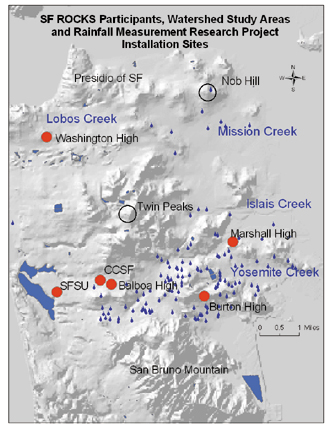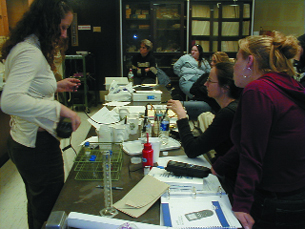Geotimes

Feature
Reaching
Out to Communities and Kids with Science
Lisa D. White, Karen Grove, David Dempsey, Oswaldo Garcia, Newell
Garfield, Tara Kheradyar, Matthew J. La Force, Raymond Pestrong and Britt Thorpe
Students need better training at the K-12 level if they are to pursue geoscience
degrees in college. Therefore, in September 2001, with a five-year grant from
the National Science Foundation, we decided to create a program that would engage
K-12 educators and students in the geosciences, while also introducing a more
ethnically mixed student population to the field.
“Reaching Out to Communities and Kids with Science in San Francisco”
(SF-ROCKS) is a partnership between the geosciences department at San Francisco
State University (SFSU), the City College of San Francisco (CCSF) and the San
Francisco Unified School District. Part of the NSF Geosciences Directorate’s
“Opportunities to Enhance Diversity in the Geosciences” program, the
partnership aims to introduce diverse groups of high school students to the
earth sciences and increase the number of traditionally underrepresented students
who enter college as geoscience majors.
Our long-term goal is to recruit more geoscience majors to SFSU so that our
department more accurately reflects the diverse demographics of the San Francisco
Bay Area. Shifting trends in geoscience careers, with a greater emphasis on
environmental and applied geosciences, have led us to select SF-ROCKS topics
that are relevant to the community.
 We started
with the students and faculty at Phillip and Sala Burton Academic High School
(Burton High School) in southeast San Francisco and designed a community-centered,
multifaceted education and research program to study four watershed sites that
are adjacent to the school: the Islais, Yosemite, Mission, and Lobos creek watersheds.
We started
with the students and faculty at Phillip and Sala Burton Academic High School
(Burton High School) in southeast San Francisco and designed a community-centered,
multifaceted education and research program to study four watershed sites that
are adjacent to the school: the Islais, Yosemite, Mission, and Lobos creek watersheds.
This map of San Francisco shows the locations of watersheds, the SF-ROCKS participating
high schools, San Francisco State University (SFSU) and the City College of
San Francisco (CCSF), and the rain-gauge installations sites (rain drops). The
SF-ROCKS program aims to engage educators and students in science while encouraging
participation among ethnic minority groups. Courtesy of Lisa White.
“Why a watershed?” is a question we often hear when describing the
contextual focus for the SF-ROCKS program. Watersheds, we reply, provide an
integrated framework to investigate geoscience subdisciplines with environmental
implications. In the Islais Creek and Yosemite Creek watersheds, in particular,
a history of environmental problems stemming from industrial misuse form an
important context for studying the geosciences.
The geoscience department at SFSU offers degrees in geology, meteorology and
oceanography. Faculty members in the department work across their disciplines
and are involved in a variety of inquiry-driven, active-learning strategies
to improve geoscience education.
The program seeks to enhance student curricula and provide teacher training,
and also encourages tiers of mentoring relationships between high school students,
college students, high school educators and university professors.
Creating a community
 A core component
of SF-ROCKS is a series of 15 lesson plans, tied to California’s state
science standards, that encourage teachers to supplement their existing 9th-grade
interdisciplinary science course curriculum with the educational materials and
activities that we have developed. By focusing on the unique watershed environments
that surround their school, students learn how earth science concepts apply
to their own neighborhood. Lesson plans include elements such as constructing
watershed and topographic models, studying the plate tectonic setting of San
Francisco, and investigating the hydrogeology of watersheds and the meteorology
of the Bay Area.
A core component
of SF-ROCKS is a series of 15 lesson plans, tied to California’s state
science standards, that encourage teachers to supplement their existing 9th-grade
interdisciplinary science course curriculum with the educational materials and
activities that we have developed. By focusing on the unique watershed environments
that surround their school, students learn how earth science concepts apply
to their own neighborhood. Lesson plans include elements such as constructing
watershed and topographic models, studying the plate tectonic setting of San
Francisco, and investigating the hydrogeology of watersheds and the meteorology
of the Bay Area.
Teachers and interns explore the use of probes and other equipment to test water
quality, as part of the SF-ROCKS program. Photo courtesy of Lisa D. White.
The SF-ROCKS faculty at SFSU introduce science teachers to the lesson plans
during a summer workshop. Additional content and pedagogy training takes place
during Saturday workshops held throughout the academic year. Teachers receive
an annual stipend for their participation and a generous supply of teaching
materials to carry out the lesson plans and activities.
The SF-ROCKS Web site (sf-rocks.sfsu.edu)
and lesson plans have three purposes: to provide the SF-ROCKS high-school teachers
with information and resources from the summer and Saturday workshops, including
access to the SF-ROCKS lesson plans, maps and other digital materials; to introduce
the SF-ROCKS interns to the lesson plans and acquaint them with their role in
facilitating the activities; and to provide the general geoscience educational
community with teaching resources and information about the SF-ROCKS project.
Britt Thorpe, a geography graduate student at SFSU, is the project Web manager
and curriculum specialist. A credentialed middle-school teacher, she has been
instrumental in guiding the SF-ROCKS faculty in developing lesson plans appropriate
for 9th-grade students. Working with the project’s GIS consultant, Thorpe
has begun to use ArcINFO and ArcIMS software on the project server to compile
data and display maps. We plan to develop more Web-accessible GIS tools and
to incorporate interactive map layers showing rainfall, water quality and rock
and soil data.
During the 2002-2003 academic year at Burton High School, for example, more
than 100 students participated in the rain-gauge project by collecting and reporting
rainfall from simple rain gauges installed in the backyards of their homes (http://sf-rocks.sfsu.edu/ozlp_1.htm).
SF-ROCKS meteorology professors Oswaldo Garcia and David Dempsey will analyze
data from the rain gauges and incorporate it into future lesson plans about
tracking rainfall associated with mid-latitude storms.
The 15 lesson plans were developed by SF-ROCKS and the geosciences faculty in
consultation with the Burton High School integrated science teachers. Assessment
and revision of the lesson plans and associated activities are ongoing, and
the teachers and interns have provided valuable feedback about their effectiveness.
Although teachers can use the existing lesson plans in any order, the plans
are most logically grouped into three unit sequences: Watersheds; Rocks, Plate
Tectonics, and Geologic Maps; and Weather and the Rain Gauge Project.
Mentoring
During each year of the program, we select six to eight undergraduate students
from SFSU and CCSF to help the science teachers implement SF-ROCKS lesson plans
in the classroom. Most of these interns are geoscience majors. They serve as
mentors to the 9th-grade students and assist the teachers on a weekly basis
in the classrooms. Interns train with the teachers during summer and Saturday
workshops, where SFSU geoscience faculty members provide instruction about earth
science content and pedagogical approaches. The interns also have opportunities
to work directly with the SF-ROCKS faculty on research projects in the watershed.
During the 2002-2003 academic year, for example, they participated in water-quality
testing of creeks surrounding Burton High.
Summer Institute
During a two-week summer research institute last month, SF-ROCKS faculty worked
closely with 14 students who are entering 10th grade at Burton High School this
fall. These students were the first group that we introduced last year to the
SF-ROCKS project in their science classes. Our goal was to teach them, via supervised
research projects, about their neighborhood watersheds in ways that would inspire
them to learn more about the application of geoscience to the study of environmental
problems. Southeast San Francisco is heavily industrialized, with a long history
of environmental problems. We trained these young people to evaluate and understand
how industrialization has changed the area where they live and attend school.
The high-school students who participated in the summer institute will present
scientific posters highlighting their work at the American Geophysical Union
meeting in December.
Expanding the program’s scope
We have invited three more high schools and five additional teachers to join
the program for academic year 2003-2004. This expansion moves us beyond the
initial focus of watersheds in southeast San Francisco to other parts of the
city. It also brings us closer to the long-term goal of involving at least five
San Francisco high schools in the SF-ROCKS program during the NSF funding period
(2001-2006).
Last year at Burton High School, more than 400 freshmen from a wide range of
ethnic backgrounds became engaged in many different active-learning modules
from the SF-ROCKS program curriculum. We are starting to analyze the student
responses to our assessment instruments and plan to use them to improve the
design and effectiveness of the student learning experience. Expansion of the
SF-ROCKS lesson plans and Web site provides more high-school teachers with information
and resources to improve their integrated-science curricula. Instead of replacing
the existing course of study, we continue to apply a model that complements
the curriculum and builds on the strengths of the teachers and the geologic
settings of the schools.
Because earth science is a mandate of national and California state science
education standards for middle schools, we are also exploring ways to expand
the SF-ROCKS program to middle schools in the San Francisco Unified School District.
White is a professor of geology
at SFSU and the principal investigator of the SF-ROCKS project. E-mail: lwhite@sfsu.edu.
Co-PIs in the SFSU Department of Geosciences are Karen Grove, David Dempsey, Oswaldo
Garcia, Newell Garfield, Matthew J. La Force, Raymond Pestrong and Tara Kheradyar.
Britt Thorpe is a graduate student in the Department of Geography and Human Environmental
Studies at SFSU.
Back to top
 We started
with the students and faculty at Phillip and Sala Burton Academic High School
(Burton High School) in southeast San Francisco and designed a community-centered,
multifaceted education and research program to study four watershed sites that
are adjacent to the school: the Islais, Yosemite, Mission, and Lobos creek watersheds.
We started
with the students and faculty at Phillip and Sala Burton Academic High School
(Burton High School) in southeast San Francisco and designed a community-centered,
multifaceted education and research program to study four watershed sites that
are adjacent to the school: the Islais, Yosemite, Mission, and Lobos creek watersheds.
 A core component
of SF-ROCKS is a series of 15 lesson plans, tied to California’s state
science standards, that encourage teachers to supplement their existing 9th-grade
interdisciplinary science course curriculum with the educational materials and
activities that we have developed. By focusing on the unique watershed environments
that surround their school, students learn how earth science concepts apply
to their own neighborhood. Lesson plans include elements such as constructing
watershed and topographic models, studying the plate tectonic setting of San
Francisco, and investigating the hydrogeology of watersheds and the meteorology
of the Bay Area.
A core component
of SF-ROCKS is a series of 15 lesson plans, tied to California’s state
science standards, that encourage teachers to supplement their existing 9th-grade
interdisciplinary science course curriculum with the educational materials and
activities that we have developed. By focusing on the unique watershed environments
that surround their school, students learn how earth science concepts apply
to their own neighborhood. Lesson plans include elements such as constructing
watershed and topographic models, studying the plate tectonic setting of San
Francisco, and investigating the hydrogeology of watersheds and the meteorology
of the Bay Area.